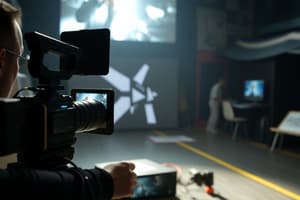Podcast
Questions and Answers
What is editing?
What is editing?
The process (art and technique) by which individual shots are assembled into a cinematic whole.
What was 'Cutting and Splicing' used for before digital editing?
What was 'Cutting and Splicing' used for before digital editing?
- To add sound to films
- To create special effects
- To cut, glue, and tape film together (correct)
- To project films
What does the term 'Technique' refer to in editing?
What does the term 'Technique' refer to in editing?
The joining together of two shots; cutting and splicing.
What is meant by 'Craft' in film editing?
What is meant by 'Craft' in film editing?
What is a 'Shot'?
What is a 'Shot'?
What does 'Take' indicate?
What does 'Take' indicate?
What is 'Cut' in editing?
What is 'Cut' in editing?
What is the Kuleshov Effect?
What is the Kuleshov Effect?
What does Montage Editing achieve?
What does Montage Editing achieve?
Who is the Editor in film production?
Who is the Editor in film production?
What are the Editor's Responsibilities?
What are the Editor's Responsibilities?
What are Spatial Relationships in film editing?
What are Spatial Relationships in film editing?
What are Temporal Relationships?
What are Temporal Relationships?
What is a Flashback?
What is a Flashback?
What is a Flash-forward?
What is a Flash-forward?
What does Ellipsis refer to?
What does Ellipsis refer to?
What is Montage?
What is Montage?
How does editing affect Rhythm in film?
How does editing affect Rhythm in film?
What are the two Editing Approaches?
What are the two Editing Approaches?
What does Continuity in editing seek to achieve?
What does Continuity in editing seek to achieve?
What is Discontinuity in film editing?
What is Discontinuity in film editing?
What is the Master Scene Technique?
What is the Master Scene Technique?
What is a Master Shot?
What is a Master Shot?
What is the 180° Rule?
What is the 180° Rule?
What are some Techniques to Maintain Continuity?
What are some Techniques to Maintain Continuity?
What is Shot/reverse shot?
What is Shot/reverse shot?
What are Match cuts?
What are Match cuts?
What does Eye-line match involve?
What does Eye-line match involve?
What is Point-of-view editing?
What is Point-of-view editing?
What is Parallel Editing?
What is Parallel Editing?
Flashcards are hidden until you start studying
Study Notes
Editing Overview
- Editing is the art and technique of assembling individual shots into a cohesive cinematic whole.
- Cutting and splicing was a manual editing process used before digital technology, involving physically cutting and gluing film.
Key Terminology
- A shot is the basic unit of film editing, representing one continuous camera run.
- A take refers to how many times a specific shot has been filmed.
- The cut is the fundamental editing tool that marks the transition from one shot to another.
- The Kuleshov Effect demonstrates how audience interpretation changes based on the sequence of shots.
Editing Techniques
- Montage editing juxtaposes shots to create new meanings and manipulate viewer perception.
- Editors are responsible for spatial and temporal relationships, as well as the overall rhythm of the film.
Relationships in Editing
- Spatial relationships expand understanding of a scene's space through the arrangement of shots.
- Temporal relationships include techniques like flashbacks, flash-forwards, ellipsis, and montage, influencing the narrative timeline.
Specific Techniques
- Flashback interrupts the present with scenes from the past, common across genres.
- Flash-forward showcases future events, providing glimpses beyond the current timeline.
- Ellipsis refers to the omission of time or events between scenes for pacing or narrative focus.
Master Techniques
- The master scene technique uses various shots, from wide to close-ups, to capture a scene comprehensively.
- A master shot is a long continuous take that covers characters and actions within a scene.
Continuity Editing
- The 180-degree rule helps maintain screen direction by keeping the camera on one side of an imaginary line between main subjects.
- Techniques to uphold continuity include:
- Shot/reverse shot: alternates between shots of characters (A-B-A).
- Match cuts: connects two shots through similar action or subject.
- Eye-line match: shows a character looking at something followed by what they see.
- Point-of-view editing: presents the perspective of a specific character or group.
Rhythm and Approaches
- Editing influences a film's rhythm through shot duration control.
- Two main editing approaches are:
- Continuity seeks a smooth, logical flow (invisibility).
- Discontinuity deliberately disrupts narrative coherence through mismatches in various elements like location or lighting.
Parallel Editing
- Also known as cross-cutting, this technique intersperses two or more lines of action occurring simultaneously in different locations, creating a dynamic narrative structure.
Studying That Suits You
Use AI to generate personalized quizzes and flashcards to suit your learning preferences.




